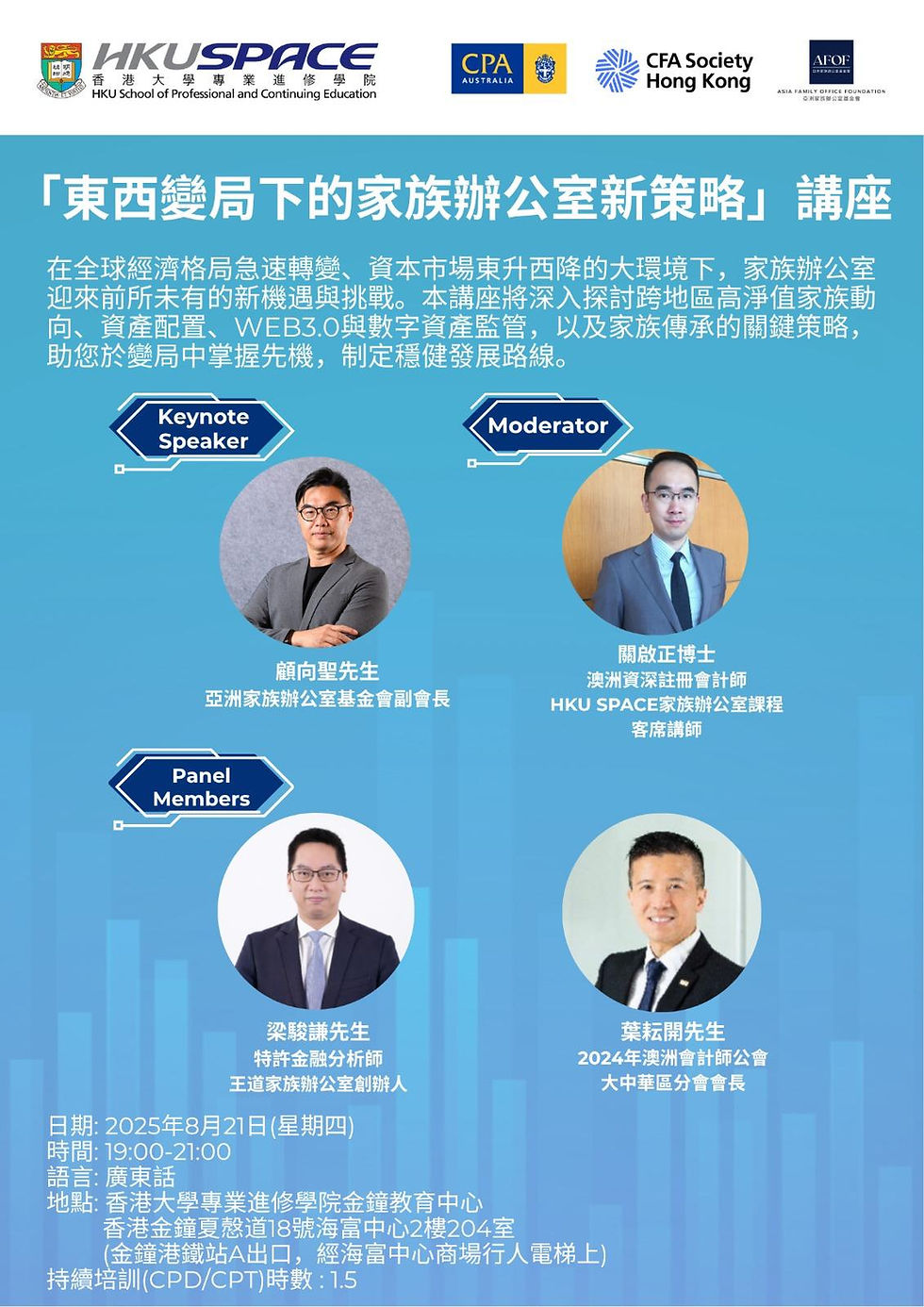Exploring the Evolution of Philanthropy in Family Offices: Insights, Trends, and Impactful Strategies
- Lam Stefansen
- Feb 7
- 4 min read
Philanthropy is changing rapidly, especially within family offices. As wealthy families seek purpose in their giving, family offices are rethinking the role of philanthropy. It's no longer just about donating money; it's about making a real difference and nurturing sustainable change in communities. This post will highlight the new trends in philanthropy among family offices in Asia, showcase successful case studies, and offer actionable advice for building effective philanthropic programs.
Trends in Philanthropic Activities Among Family Offices in Asia
Family offices in Asia are transforming their approach to philanthropy. In the past, giving was often irregular and focused on one-time projects. Today, there's a strong shift towards long-term commitments that prioritize measurable impacts.
Increased Focus on Impact Investing
Impact investing is on the rise, with family offices now looking to achieve both financial returns and social or environmental benefits. For example, according to the Global Impact Investing Network, the impact investing market reached $715 billion in 2020. Family offices are increasingly directing their investments into sustainable projects that provide real societal benefits. For instance, the Chan Zuckerberg Initiative supports education, housing, and health startups with the goal of balancing financial success with social good.
Collaborative Philanthropy
Collaboration is becoming a vital theme in philanthropy. Many family offices are partnering with non-profits, government agencies, and other philanthropic organizations to enhance their efforts. This collaborative approach allows them to share resources, expertise, and networks, leading to more effective interventions. For example, the Tata Group in India often collaborates with local NGOs and government bodies to launch initiatives in community health and education, making their impact broader and deeper.
Data-Driven Strategies
Data is playing a crucial role in assessing the success of philanthropic efforts. Family offices in Asia are increasingly using data analytics to understand the impact of their giving. With tools that allow for real-time tracking of outcomes, they can measure success more accurately and refine their strategies effectively. According to a survey by Bridgespan Group, organizations that utilize data to guide their philanthropy report a 25% increase in overall effectiveness.
Case Studies of Successful Philanthropic Endeavors by Family Offices
The Singtel Group Foundation
The Singtel Group Foundation, affiliated with a leading telecommunications company in Asia, is a prime example of strategic philanthropy. Focused on education and technology, they have initiated scalable programs aimed at supporting underprivileged youth. Their partnerships with local NGOs have allowed them to reach over 10,000 students, providing access to digital learning through technology-driven solutions. This collaborative effort has not only improved educational outcomes but also empowered communities by ensuring that students are equipped with valuable digital skills.
The Lee Kum Kee Family
The Lee Kum Kee family, renowned for their sauces, exemplifies a deep commitment to philanthropy through the Lee Kum Kee Charity Foundation. Placing a strong emphasis on nutrition and health, they fund community health programs and provide scholarships to underprivileged youth. Their initiatives in rural areas aim to improve health education, showing significant progress, such as a 30% increase in awareness about nutrition in targeted communities. By actively involving local stakeholders in program planning and execution, they ensure that their initiatives are both relevant and impactful.
Guidance on Creating Sustainable and Impactful Philanthropic Programs
Creating a successful philanthropic program requires thoughtful planning and strategy. Here are some key considerations for ultra-high-net-worth individuals (UHNWIs) who want to make a significant impact:
Define Clear Objectives
Before starting philanthropic ventures, family offices should pinpoint their core values and goals. Knowing which issues matter most to them will lead to more focused and effective giving. This clear vision helps align projects with the family's overall mission, ensuring that their resources are spent wisely.
Engage in Community Needs Assessment
Thoroughly understanding local community needs is crucial. By working closely with local stakeholders, families can identify projects that will genuinely create change. This approach not only strengthens community ties but also fosters a sense of ownership among beneficiaries, making programs more effective.
Develop Metrics for Success
Successful philanthropic initiatives must be measurable. Setting key performance indicators (KPIs) allows family offices to monitor progress and evaluate their effectiveness. Utilizing data here can yield insights that help improve future strategies, ensuring that every effort counts.
Foster Intergenerational Involvement
Involving younger family members in philanthropic activities is vital for sustainability. By integrating them in discussions and planning, families can cultivate a culture of giving. Educating the next generation about philanthropy motivates them to contribute fresh ideas and perspectives, ensuring ongoing engagement.
Prioritize Transparency and Accountability
Maintaining transparency builds trust among family members and partners. Open communication regarding successes, challenges, and financial allocations enhances relationships and keeps collaborative efforts aligned with shared goals.
Looking Ahead
The future of philanthropy in family offices is dynamic and promising. With a focus on meaningful impact and sustainable change, family offices in Asia are creating structures that align charitable activities with their values and investment strategies. By learning from successful case studies and implementing effective practices, UHNWIs can build philanthropic programs that resonate with their mission and create significant transformations in the communities they serve.
As these family offices explore the potential of their philanthropic initiatives, it is essential to remember that true impact comes from commitment, collaboration, and a well-thought-out strategy. This evolving landscape has the power to reshape philanthropy, transforming it from a mere act of charity into a strong driver of change.






